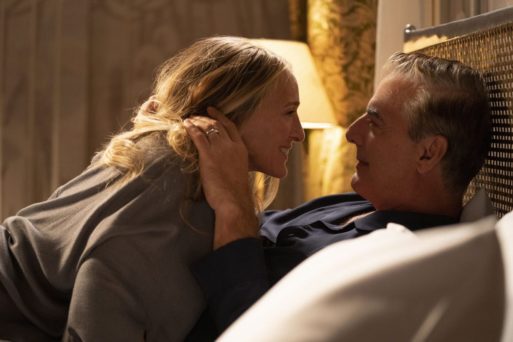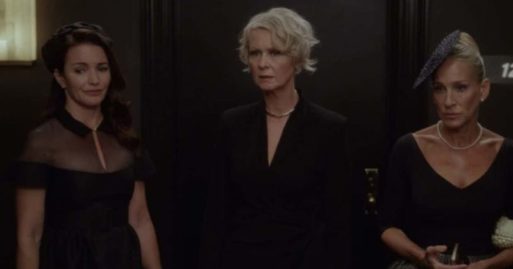
Seventeen years after its initial run, HBO has brought back its groundbreaking series Sex and the City, calling it a new chapter. This reboot follows three of its four original protagonists as they navigate new experiences, like parenting teen children and chasing an old dream of law school. From the first episode, writers have given its characters tough older adult experiences–most poignantly the death of a spouse and what planning a funeral looks like.
What Happens Now?
The first episode of “And Just Like That…,” “Little Black Dress,” ends with the dramatic death of Carrie’s husband, Big, who dies from a heart attack. The two were married in the first film installment of the series. When we see Carrie next, she is opening the door for her friend Miranda, who she called to tell of her husband’s death. When Carrie sees her friend, she immediately says, “What happens now?” Miranda, seeing the paramedics with Big on a gurney behind Carrie replies, “I think they take him away.” But Carrie asks the question again. “What happens now?” She wants to know what life could possibly be like without her love.

Carrie and Big share an intimate moment before his sudden heart attack.
After Death Decisions
The next morning, Carrie browses funeral websites, unsure of where to turn for services. The swanky funeral home she clicks on offers an advertisement video on its homepage, and she seems unsure of how to feel, looking at couples who she may feel are much older than she is. Once she arrives at the swanky funeral home, she quickly realizes this isn’t what her husband would want. She’s got to figure out how to honor Big in a way that feels right to her. She’s not willing to go the traditional route just because it may be easier. Those who have had to say goodbye to loved ones know it can be difficult to choose how to honor their memory and plan a memorial.
Carrie ends up opting for what Vulture magazine calls “funeral chic” in the minimalist space of an art gallery with simple white chairs. She requests no flowers, though she softens her stance when an estranged friend sends some just hours before the service. Carrie writes a eulogy but has Miranda share it. Big’s older brother says a very few words, and they play a slideshow of photos and vignettes of Big as a child.

Managing Other People’s Grief
However, Carrie’s dilemma over how to honor her loved one and make after death decisions is only one of her stressors during this traumatic time. It seems every other character has a way of making Big’s death, the funeral, and how Carrie is reacting to it all about themselves.
From one of her best friends, Charlotte, blaming herself for Big’s death, to her best guy friend, Stanford, caring more about the assigned seats at the funeral than allowing a grieving guest a chance to say goodbye to Big, Carrie gets little help through the process. In fact, the episode serves to show how our culture still feels awkward about death. Each tragedy serves only as reminder to cherish and care for those left behind. But what about the dead?
Carrie barely cries throughout the episode, using fingers to wipe away invisible tears during Miranda’s eulogy and Big’s celebration slideshow. Many of the other guests are visibly more emotional throughout the service. Viewers are left wondering if Carrie is still in shock, and if she will ever deal with the pain. Perhaps in a future episode?

Charlotte (left) Miranda and Carrie (right) at Big’s funeral
Most disturbing of all is a funeral guest who assures Carrie that she “knows what it’s like” to lose a husband since she recently lost hers at the start of the pandemic. Instead of consoling Carrie, she just tells her how no one else knows, but she does, which isn’t comforting at all.
For anyone who’s lost a loved one, Carrie’s experiences could be both relatable and a little out of touch. However, when Big’s ashes arrive in a plain cardboard shipping box with no padding as the urn slides around in it, it’s perhaps too real. The callousness of the mortuary who didn’t call the bereaved widow to tell her that her husband’s remains would arrive that day and the limited packaging serves to show how negligence can deepen a wound.
Victoria Haneman, Frank J. Kellegher Professor of Trusts & Estates at Creighton University School of Law, believes we are still trying to avoid death as a society. She remarks how we hide our elderly and signs of aging. We prefer to make death and illness invisible. It’s because of this reluctance to embrace death that funeral planning remains such a fraught experience that often only adds to the trauma of loss. Perhaps if more beloved characters wrestle with what to do after a death on the screen, the public will seek out alternative ways to celebrate their loved ones. Or at lease we’ll get more comfortable talking about these things.

 And Just Like That: A new chapter of Sex and the City by Hbo/Max
And Just Like That: A new chapter of Sex and the City by Hbo/Max


 John Mulaney’s “Funeral Planning” on Netflix: No Real Plan
John Mulaney’s “Funeral Planning” on Netflix: No Real Plan

 Composting Bodies Is Now Legal in a Dozen States
Composting Bodies Is Now Legal in a Dozen States














